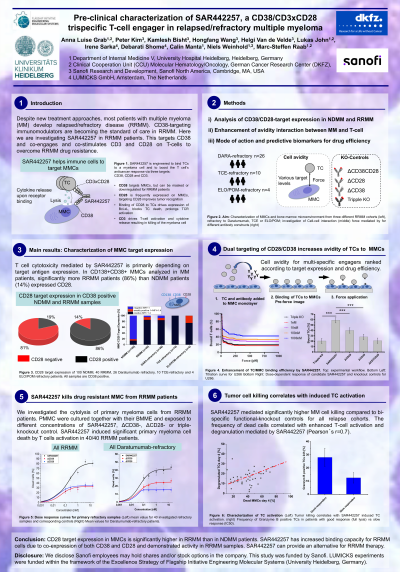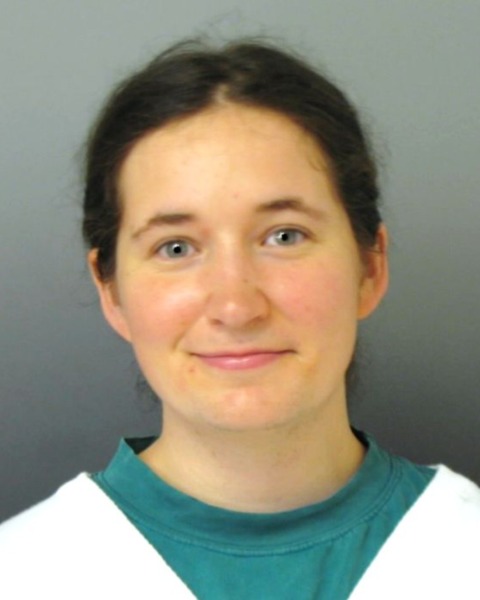Treatment of Relapsed/Refractory Myeloma
Poster Session 2
P-266: Pre-clinical characterization of SAR442257, a CD38xCD28xCD3 trispecific T-cell engager in relapsed/refractory multiple myeloma
Thursday, September 28, 2023
12:30 PM - 1:30 PM EEST


Anna L. Grab
Postdoc
DKFZ
Heidelberg - Germany, Germany
Introduction: Despite new treatment approaches, most patients with multiple myeloma (MM) develop relapsed/refractory disease (RRMM). CD38-targeting immunomodulators are becoming the standard of care in RRMM. Here we are investigating the first time SAR442257, an anti-CD38/CD3xCD28 trispecific antibody for RRMM. This antibody targets CD38-on MM cells and has a cross-over dual variable (CODV), anti-CD3xCD28 arm that can co-engage and co-stimulate CD3 and CD28 on T-cells, We therefore investigated i) the CD38/CD28-target expression of 100 NDMM and 40 RRMM patients, ii) the enhancement of avidity interaction between MM and T-cell, , and iii) the mode of action as well as predictive biomarkers for drug efficiency in 40 RRMM patients (cohort 1: Daratumumab-relapse, 2: Bite-relapse, 3: ELO/POM-relapse).
Methods: i) We determined the CD28/CD38 expression with FACS and ii) measured cell interaction force between T-cells and MM cells mediated by SAR442257 using a microfluidic approach. iii) The composition of RRMM bone marrow microenvironment was characterized one month after last therapy. For functional assays, CD138+ MM cells and CD3+ T-cellss were isolated from bone marrow of 40 RRMM patients. Dose dependent TC activation, cytokine release and MM cell lysis were measured with FACS.
Results: The T cell cytotoxicity mediated by SAR442257 is influenced by the binding avidity, primarily depending on target antigen expression. Significantly more RRMM patients (86%) than NDMM patients (14%) expressed CD28, and cell avidity for multi-specific engagers ranked according to target expression (MFI CD38: 380-64000; MFI CD28: 70-1400), reaching more than 50% T-cell-to-MM cell-binding within the first 7min of interaction time. Functional assays showed RRMM patients with Daratumumab-, BiTE- or ELO/POM-treatment could independently be grouped in 2 drug-efficiency-cohorts at 1nM SAR442257: the highly responsive cohort was characterized by complete lysis of MM cells, 80% of autologous T-cell-activation, and patients with Daratumumab-relapse had additionally a factor of 20 lower TGF-B levels. SAR442257 mediated significantly higher MM cell killing compared to bi-specific functional-knockout controls for all relapse cohorts, which correlated with enhanced T-cell activation and degranulation (Pearson´s r=0.7).
Conclusions: SAR442257 has increased binding capacity for RRMM due to CD38 and CD28 targets and demonstrated activity on RRMM cells as reasonable alternative for future RRMM therapy approach.
Methods: i) We determined the CD28/CD38 expression with FACS and ii) measured cell interaction force between T-cells and MM cells mediated by SAR442257 using a microfluidic approach. iii) The composition of RRMM bone marrow microenvironment was characterized one month after last therapy. For functional assays, CD138+ MM cells and CD3+ T-cellss were isolated from bone marrow of 40 RRMM patients. Dose dependent TC activation, cytokine release and MM cell lysis were measured with FACS.
Results: The T cell cytotoxicity mediated by SAR442257 is influenced by the binding avidity, primarily depending on target antigen expression. Significantly more RRMM patients (86%) than NDMM patients (14%) expressed CD28, and cell avidity for multi-specific engagers ranked according to target expression (MFI CD38: 380-64000; MFI CD28: 70-1400), reaching more than 50% T-cell-to-MM cell-binding within the first 7min of interaction time. Functional assays showed RRMM patients with Daratumumab-, BiTE- or ELO/POM-treatment could independently be grouped in 2 drug-efficiency-cohorts at 1nM SAR442257: the highly responsive cohort was characterized by complete lysis of MM cells, 80% of autologous T-cell-activation, and patients with Daratumumab-relapse had additionally a factor of 20 lower TGF-B levels. SAR442257 mediated significantly higher MM cell killing compared to bi-specific functional-knockout controls for all relapse cohorts, which correlated with enhanced T-cell activation and degranulation (Pearson´s r=0.7).
Conclusions: SAR442257 has increased binding capacity for RRMM due to CD38 and CD28 targets and demonstrated activity on RRMM cells as reasonable alternative for future RRMM therapy approach.
